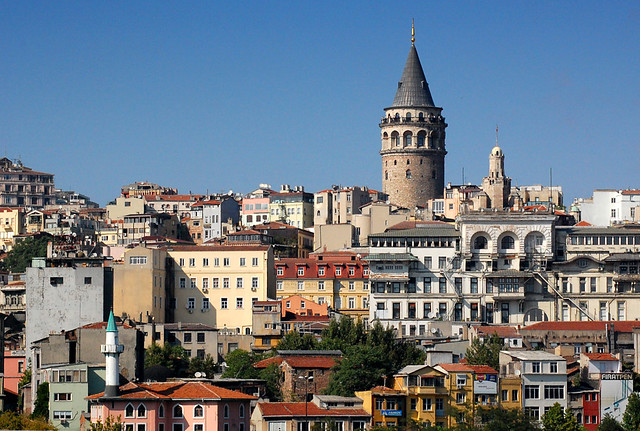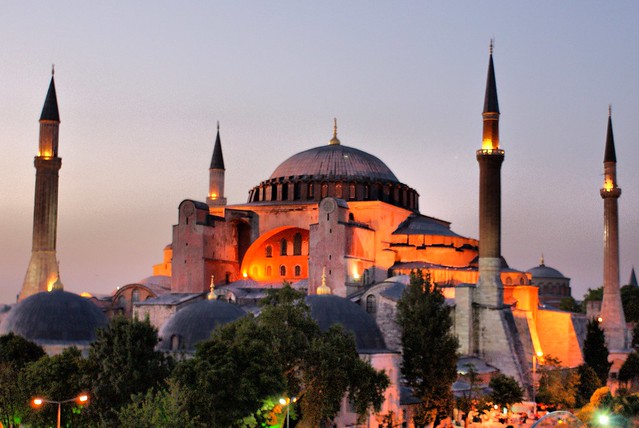stanbul is a city that wears its cultures and history well, blending them into an exciting city that has much to offer travelers from around the world. Founded during Neolithic times, Istanbul today is a modern city that remains true to its historic heritage through its mosques, basilicas and cathedrals, and ancient bazaars. Standing between the East and the West, Turkey’s largest city offers an aura of intrigue and charm that will appeal to all visitors. An overview of the top tourist attractions in Istanbul:
10Galata Tower
 flickr/onnufry
flickr/onnufry
At 67 meters (219 feet) high, the Galata Tower rules over the Istanbul skyline, offering great views of the old city and its surroundings. The medieval stone tower, known as the Tower of Christ, was the tallest building in Istanbul when it was built in 1348. It still stands tall over Istanbul today. The tower has been modified over the centuries, at one time being used as an observation tower to spot fires. Today, its upper reaches include a café, restaurant and a night club, both reached by elevator in the nine-story building, where one can find the stunning vistas.
9Istanbul Archaeological Museum
 flickr/Bochum1805
flickr/Bochum1805
One of the most important museums in Turkey, the Istanbul Archaeological Museum is actually three museums: the Archaeological Museum, the Ancient Orient Museum and the Tiled Kiosk Museum. The three museums combined contain more than 1 million objects from civilizations around the world. Founded in 1891, it was the first Turkish museum, and was located on the Topkapi Palace grounds. The Tiled Kiosk dates back to 1472. The museums contain thousands of precious artifacts, including the sarcophagus of Alexander the Great.
8Chora Church
 flickr/kahumphrey
flickr/kahumphrey
The Chora Church may be a little bit off the beaten tourist path, but visitors say the beautiful Byzantine art is well worth the effort to get there. Magnificent mosaics and frescoes depict the life of Jesus and his mother, Mary. Known as the Church of the Holy Savior in Chora, it has been described as one of the most beautiful surviving works of Byzantine architecture. Dating back to the days of Constantine, the Chora was a monastery in its early years; a few centuries later, it became a mosque, and in 1948, it was converted to a museum.
7Basilica Cistern
 flickr/kahumphrey
flickr/kahumphrey
The Basilica Cistern has been providing Istanbul residents with water since the sixth century when it was ordered built by the Roman Emperor Justinian I. A visit leaves travelers raving about the technology the ancient Romans used to build this architectural wonder that was very advanced for its day. The underground cistern, just a few steps away from the Blue Mosque, was built on the site of a basilica that was constructed in the third century. Known as the Sunken Palace, the cistern can hold up to 2.8 million cubic feet of water. The cistern is one of the locations used in From Russia with Love, a James Bond thriller filmed in 1963.
6Dolmabahce Palace
 flickr/P Gonzales
flickr/P Gonzales
Luxurious, plush and beautiful are just some of the adjectives used to describe the Dolmabahce Palace, which has been compared to the Palace of Versailles. Built in the 19th century using 14 tons of gold leaf, Turkey’s most glamorous palace blends traditional Ottoman architecture with the European styles of Neoclassical, Baroque and Rococo. Home to six sultans from 1856 to 1924, it also is home to the world’s largest Bohemian crystal chandelier, a gift from Queen Victoria. The Dolmabahce Palace’s setting is stunning: It was built along the Bosphorus coastline.
5Suleymaniye Mosque
 wikipedia/Winstonza
wikipedia/Winstonza
Visitors to the Suleymaniye Mosque say its beauty and peacefulness gives them an inspiring sense of spirituality. Located on the Third Hill of Istanbul, the mosque was ordered built in 1550 by the Sultan Suleyman the Magnificent. The mosque, indeed, is magnificent, blending the best of Islamic and Byzantine architecture. The mosque was extensively damaged over the years, including during World War I when a fire broke out while the gardens were used as a weapons depot. It was restored in the mid-20th century. The mosque is marked by four minarets, indicating it was built by a sultan. When it was built, the dome was the highest in the Ottoman Empire.
4Grand Bazaar
 flickr/Alaskan Dude
flickr/Alaskan Dude
Travelers who love to shop shouldn’t miss out on a visit to the Grand Bazaar, with 5,000 shops making it one of the largest indoor marketplaces in the world. Receiving more than a quarter-million visitors a day, the bazaar features such items as jewelry, carpets that may or may not fly, spices, antiques and hand-painted ceramics. The bazaar dates back to 1461 and today is home to two mosques, four fountains, two hammams or steam baths, and the Cevahir Bedesten, where the rarest and most valuable items have been found traditionally. Here is where shoppers will find old coins, jewelry with precious gems, inlaid weapons and antique furniture.
3Topkapi Palace
 flickr/Ivan Mlinaric
flickr/Ivan Mlinaric
Topkapi Palace is one of the must-see attractions in Istanbul that combines history and stunning scenery in an experience that is not to be rushed. Rich in the history of the Ottoman Empire, the Topkapi Palace is surrounded by five kilometers (3.1 miles) of stone wall with 27 towers. Topkapi, which dates back to the 15th century, is situated on a hill overlooking the Sea of Marmara, the Bosphorus and the Golden Horn. At one time it was an official royal residence of the Ottoman Empire sultans and seat of Turkish government, but is now a museum that is considered the largest and oldest palace in the world. Visitors can get a glimpse of the harem’s quarters, where the government worked, a collection of old weapons used by the sultans, the palace kitchens with a huge porcelain collection, and the treasury with its collection of jewels and clocks.
2Blue Mosque
 flickr/dachalan
flickr/dachalan
The Blue Mosque, built in the early 17th century, remains an active house of worship today. This means visitors need to time their visits carefully, as the mosque is closed to sightseers during the five daily prayer times for Muslims. All visitors must remove their shoes and women must cover their hair. This is a small price to pay for seeing its priceless treasures that include 20,000 ceramic tiles in various tulip designs and 200 stained glass windows, all with intricate designs. The mosque, built by Sultan Ahmet, takes its name from the blue tiles on the dome and the upper levels of the interior.
1Hagia Sophia
 flickr/David Spender
flickr/David Spender
The Hagia Sophia was once a house of worship that served several religions well over the centuries. It started out as a Greek Eastern Orthodox basilica that was home to the Patriarch of Constantinople when it was built in 537. For almost six decades in the 12th century it was a Roman Catholic church. It became a mosque in 1453, remaining that way until 1931, when it was closed. It reopened as a museum in 1935. At one time, it was the largest cathedral in the world at one time, and served as the inspiration for other mosques, including the Blue Mosque, as it was such a great example of Byzantine architecture. It is most famous for its mosaics depicting various religious scenes.







__1920x864.jpg)
0 comments:
Post a Comment